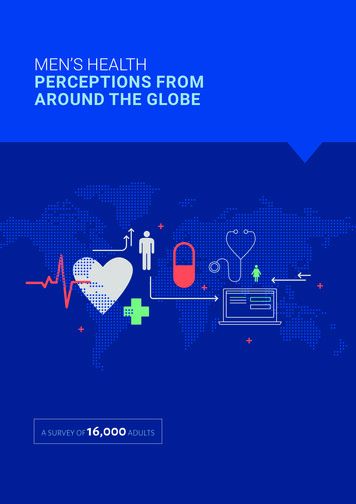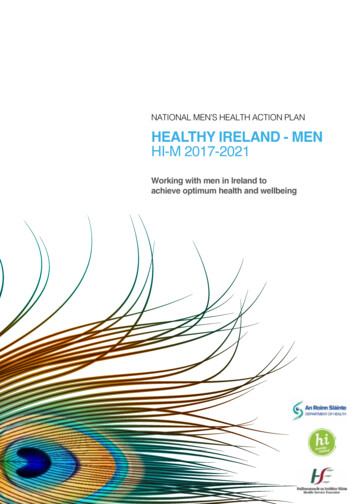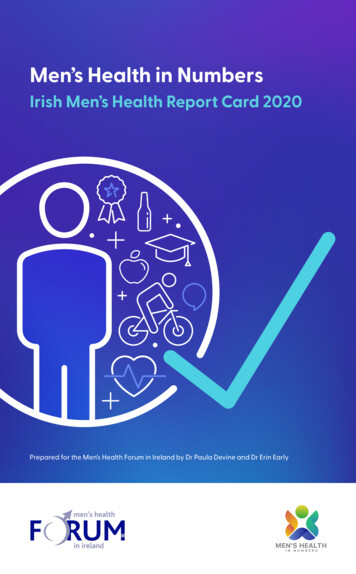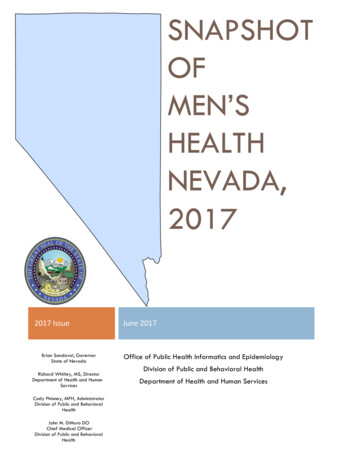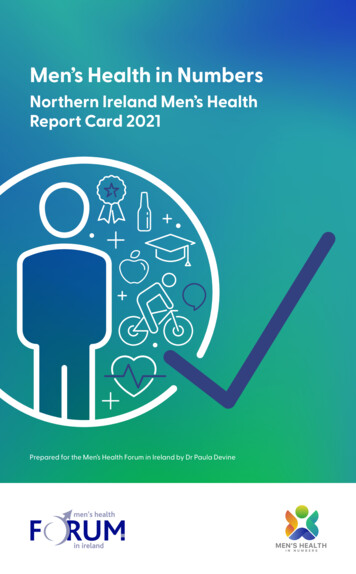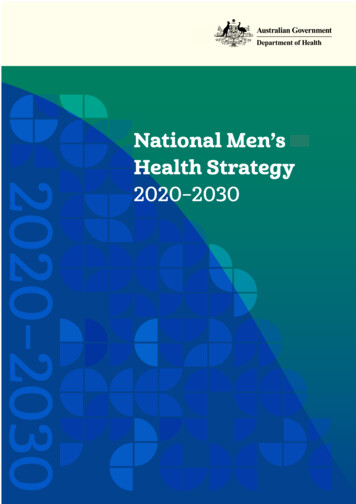
Transcription
National Men’s Health Strategy 2020-2030 1
Commonwealth of Australia as represented by the Department of Health 2019Creative Commons LicenceThis publication is licensed under the Creative Commons Attribution 4.0 International Public License available galcode (“Licence”). You must read and understand the Licencebefore using any material from this publication.RestrictionsThe Licence may not give you all the permissions necessary for your intended use. For example, other rights (suchas publicity, privacy and moral rights) may limit how you use the material found in this publication.The Licence does not cover, and there is no permission given for, use of any of the following material found in thispublication: the Commonwealth Coat of Arms. (by way of information, the terms under which the Coat of Arms maybe used can be found on the Department of Prime Minister and Cabinet lth-coat-arms);any logos and trademarks;any photographs and images;any signatures; andany material belonging to third parties.AttributionWithout limiting your obligations under the Licence, the Department of Health requests that you attribute thispublication in your work. Any reasonable form of words may be used provided that you: include a reference to this publication and where, practicable, the relevant page numbers;make it clear that you have permission to use the material under the Creative Commons Attribution 4.0International Public License;make it clear whether or not you have changed the material used from this publication;include a copyright notice in relation to the material used. In the case of no change to the material, thewords “ Commonwealth of Australia (Department of Health) 2019” may be used. In the case where thematerial has been changed or adapted, the words: “Based on Commonwealth of Australia (Department ofHealth) material” may be used; anddo not suggest that the Department of Health endorses you or your use of the material.EnquiriesEnquiries regarding any other use of this publication should be addressed to the Branch Manager,Communication Branch, Department of Health, GPO Box 9848, Canberra ACT 2601, or via e-mail tocopyright@health.gov.auNational Men’s Health Strategy 2020-2030 2
Ministerial ForewordMore than 12 million men and boys live in Australia – and, mostly, they live well. Their health is better than in mostother countries. They live longer, with the eighth highest male life expectancy (80.4 years) in the developed world.Over recent years, their health has continued to improve as their access to health care has improved.Despite this, Australian men and boys face challenges in their health and wellbeing. They die earlier than women –and more often from diseases that can be prevented. Aboriginal and Torres Strait Islander men in particular livesignificantly shorter lives than others.In 2018, I proposed the development of a new strategy for men’s health, to build on the National Male HealthPolicy released in 2010. The Policy outlined the issue of male health and the multiple areas of required focus.This resulting National Men’s Health Strategy, which will guide action over the ten years from 2020-2030, shines alight on the health of Australian men and boys.It’s forward looking with a clear blueprint for achieving its core goal – that every man and boy in Australia issupported to live a long, fulfilling and healthy life.The Strategy has been capably steered in its development by Andrology Australia, along with input from thegeneral public, health professionals, researchers, community groups, academics and policy makers. I greatlyappreciate the input, engagement and enthusiasm from all of these groups, and greatly respect their contribution.The Government’s commitment to targeted, responsive action that drives continuous improvement in the healthand wellbeing of all men and boys in Australia, and to monitoring and measuring progress in that improvement, isclearly reflected in this document.The National Men’s Health Strategy 2020–2030 is a critical step towards improving the health of all men andboys across the life course, particularly those at greatest risk of poor health – creating a healthier future for themand, more broadly, for the entire Australian community.We will all benefit from the National Men’s Health Strategy 2020–2030.The Hon Greg Hunt MPMinister for HealthNational Men’s Health Strategy 2020-2030 3
AcknowledgementsWe acknowledge the advice and support of the many organisations and individuals that have contributed tothe development of this Strategy. These include (but are not limited to) all participants in the National Men’sHealth Forum (held in August 2018), state and territory governments, organisations and individuals thatprovided submissions through the online consultation process and a group of experts who provided technicaladvice on the draft Strategy.National Men’s Health Strategy 2020-2030 4
ContentsExecutive summary . 6Why men’s health matters . 8The health of men and boys in Australia . 8Help seeking and health system usage . 8About this Strategy. 11The National Men’s Health Strategy . 11The policy and strategy context . 12An inclusive Strategy . 14The impact of diversity on health . 17What could a national focus on men’s health achieve? . 19Setting the context for action . 20Priority health issues. 20Risk factors for priority health issues. 22Strategic goals and actions . 25Goal, objectives and action areas . 25Principles for action . 26Action Areas: guiding implementation . 27Implementation – partnership and engagement . 34Achieving progress . 35Appendix APolicy and strategy context . 36Emerging strategies and national action plans . 38Appendix BHow the Strategy was developed . 39Appendix CAbbreviations . 40Appendix DReferences . 41National Men’s Health Strategy 2020-2030 5
Executive summaryThe National Men’s Health Strategy 2020-2030 (the Strategy) is a framework for action to work towards thegoal that Every man and boy in Australia is supported to live a long, fulfilling and healthy life.Australian men generally enjoy better health and longer life expectancy than men in most other countries inthe world. Yet, despite improvements, men in Australia on average have a shorter life expectancy thanwomen, and die more often than women from preventable causes. The diversity amongst men and boys inAustralia, as well as biological differences between males and females, contribute to these differences and tomales experiencing poorer health outcomes in many areas.At the heart of the Strategy are three core objectives and associated actions that are designed to drivemeaningful progress towards its goal. These include a clear commitment to: Empower and support men and boys to optimise their own and each other’s health and wellbeing; Build the evidence base for improving men’s health; and Strengthen the capacity of the health system to provide quality appropriate care for men and boys.Five priority health issues form the basis of the Strategy: Mental health; Chronic conditions; Sexual and reproductive health and conditions where men are over-represented; Injuries and risk taking; and Healthy ageing. The Strategy advocates for a life-course approach in tailoring interventions to engage andsupport Australia’s diverse men and boys across all stages of their lives.The development of the Strategy coincides with an increased international focus on men’s health and on howgender intersects with social, economic, environmental, political and cultural determinants of health,influencing exposure to risk factors and interactions with the health system.1The Strategy works in tandem with the National Women’s Health Strategy 2020-2030 and with other national,state and territory policies and strategies. It embraces the definition of health adopted by the World HealthOrganization in 1946 as a state of complete physical, mental and social wellbeing and not merely the absenceof disease or infirmity.2Health is influenced by a complex range of factors, or health determinants. Targeted actions are identified tomeet the Strategy’s goal and objectives - actions that require the engagement and collaboration of a widerange of stakeholders from across Australia. They include all levels of government, the health sector, othersectors, with peak bodies, professional associations and non-government organisations, with researchers, and,of course, with men and boys themselves.Critical to the success of this Strategy is a clear commitment to the careful planning of implementation and totaking an active approach to evaluating, monitoring and communicating progress over time.By providing a framework for gender-focused health, this Strategy renews the nation’s commitment to takingcollective action to create a healthier future for men and boys.“Better health for all cannot be achieved if the many challengescurrently facing men are left hiding in plain sight.” 3National Men’s Health Strategy 2020-2030 6
Figure 1: Summary of the National Men’s Health Strategy 2020-2030GUIDING PRINCIPLES Acknowledge the influence of gender on health Provide male-centred information, programs &services Be transparent & accountable Build on what we already have Ensure that equity drives investment & action Focus on preventionLIFE STAGESBoysPRIORITYPOPULATIONGROUPS Aboriginal &Torres StraitIslander males Males TIVES & ACTION AREAS1. Empower & support all men & boys to optimisetheir own & each other’s health & wellbeingacross all stages of their lives1.1 Recognise & value the diversity of men &boys1.2 Reduce stigma associated with the healthsystem or ill-health Mental health1.4 Address structural & systemic barriers togood health Chronicconditions2.1 Improve the knowledge & capacity of thehealth workforce2.2 Engage with men & boys to identify &reduce barriers to health system access Socially isolatedmalesPRIORITYHEALTH ISSUES1.3 Increase health literacy2. Strengthen the capacity of the health system toprovide quality care for all men & boys Male veterans Males in thecriminal justicesystemOlder menSTRATEGY GOAL Males with adisability,includingmental illness Members ofthe LGBTI communityAdult menThat every man and boy in Australia is supported tolive a long, fulfilling & healthy life Males living inrural & remoteareas Males fromCALDbackgroundsAdolescents2.3 Proactively engage men & boys inprevention & early detection activities Sexual &reproductivehealth &conditionswhere men areoverrepresented Injuries & risktaking Healthy ageing3. Build the evidence base for improving the healthof men & boys3.1 Increase & prioritise research investment3.2 Improve data availabilityHEALTH iticalIMPORTANT HEALTH ISSUES FOR MEN & BOYSAndrogen deficiencyBlood borne virusesBowel cancerCerebrovascular diseaseChronic liver diseaseChronic obstructivepulmonary disease (COPD) Coronary heart disease Dementia National Men’s Health Strategy 2020-2030 DiabetesErectile dysfunctionHepatitisInfertilityInjuriesLower urinary tract symptomsLung cancerMental ill-healthMusculoskeletal conditions 7 Prostate cancer Road accidents Sexually transmittedinfections (STIs) Stroke Suicide Testicular cancer Other priorities that mayemerge over time
Why men’s health mattersThe health of men and boys in AustraliaMany Australian men experience poor health outcomes across a variety of measures, including rates ofoverweight and obesity, diabetes or high blood glucose levels, sexually transmitted infections (STIs) andmental health and wellbeing. Males experience a greater share of the total fatal and non-fatal burden ofdisease, dying at younger ages than females and more often from preventable causes. Certain populationgroups continue to experience poor health outcomes, notably: Aboriginal and Torres Strait Islander males have higher rates of fatal and non-fatal burden for almostevery health condition, and have a high prevalence of risk factors and risk-taking behaviours. In 2012, lifeexpectancy among Indigenous males was more than 10 years lower than for non-Indigenous males.6Older males experience high rates of coronary heart disease and a growing burden from dementia andfalls.Young adult males have high levels of mental ill-health and deaths from preventable causes such assuicide and accidents, with low levels of risk-perception and high levels of risk taking contributing to manyyears of life unnecessarily lost.Some health differences between men and women are biologically based, most notably in the area of sexualand reproductive health. Despite declines in mortality, prostate cancer remains one of the leading causes ofdeath in males. Reproductive health conditions, including infertility, are common among Australian males andrepresent a high economic and social cost.A brief overview of some key points relating to the health of men and boys in Australia are provided in Figure2. These draw upon the evidence presented in The Current State of Male Health in Australia – informing thedevelopment of the National Men’s Health Strategy 2020-2030.Help seeking and health system usageIn general, males’ access to health care has improved over time, and although still behind females’ access, thegap is narrowing, particularly when maternal health care-related visits are factored in.In 2013/14, 81% of males aged 18–55 years reported seeing a GP in the previous 12 months17 and 89% hadseen at least one health-care provider.18 Access tends to increase with age, with 71% of males aged 15–24years reporting having seen a GP in the previous 12 months, rising to 96% of males aged 65 years and over.18There is a prevailing concern, however, about the content and context of men’s interactions with the healthsystem. When men access a health professional it is often for shorter consultations, and typically when acondition or illness is advanced.19 Any delay in help-seeking reduces the opportunity for early diagnosis andintervention, which can dramatically affect long-term outcomes for diseases such as cancer, chronicconditions, and for mental health conditions. Disturbingly, 72% of males don’t seek help for mental ill-health.20Consultations informing this Strategy have suggested that critical questions are not being asked and importantconversations are not being initiated by health professionals when men and boys are in contact with thehealth system. Opportunities to engage proactively with men and boys, to assess risk, provide healtheducation and undertake health promotion across a range of issues are not being fully explored and representan area of significant potential to address.Access issuesThere are a range of factors that affect the way in which men and boys in Australia interact with the healthcare system. This extends from availability of services and a skilled workforce through to the way that servicesare offered. The spectrum of access issues are particularly pertinent to rural and remote communities.Strategies to remove such barriers need to consider the many determinants of health and wellbeing includingissues of trauma and mistrust of government and the health system. Examples include:National Men’s Health Strategy 2020-2030 8
Flexible practice hours for GPs and medical clinics;Recognising affordability/cost barriers for men in lower socio-economic groups;Providing male doctors/health care professionals for those men and boys with a preference for males;Expanding the availability of male-focused community health services and interventions;Expanding the maternal and child health infrastructure to include fathers – e.g. ‘parental and childhealth’;Investing in outreach programs that seek to connect with men at workplaces or in appropriate socialsettings (e.g. sporting clubs, workplaces and Men’s Sheds);Promoting and supporting the use of digital health services that are available (e.g. digital mental healthservice Head to Health);Improving health literacy through greater education about the importance of prevention, early detectionand accessing health care services; andReducing stigma associated with health care, ill-health or help-seeking.21National Men’s Health Strategy 2020-2030 9
Figure 2:Men’s health at a glanceNational Men’s Health Strategy 2020-2030
About this StrategyThe National Men’s Health StrategyThere are over 12 million men and boys living in Australia.4 In global terms, Australian men and boysexperience good health and wellbeing, and had the eighth highest male life expectancy (80.4 years) of theOrganisation for Economic Co-operation and Development (OECD) countries in 2016.5 Australia is one of only12 countries to have a male life expectancy over 80 years. As is true for all Australians, the health of Australia’smales has improved over time as evidenced by many indicators; however, there are specific areas of malehealth where gains have not been made and these require particular focus, either across the whole populationor for specific population groups.The Strategy highlights the opportunities that arise from applying a gender-informed lens to the health andwellbeing of Australians. It identifies priority areas of action to drive improvement in the health and wellbeingof all Australian males, particularly those at greatest risk of poor health (see Table 1).The focus of the Strategy is on both men and boys, acknowledging the roles of individuals as well as parents,partners, families, communities, all layers of the health system, and all areas and levels of government, insupporting their health and wellbeing. It also acknowledges and responds to the diversity that exists amongand between Australians of all genders.The Strategy recognises the changes in evidence and in the policy environment since 2010, and identifies thecurrent gaps and emerging issues in men’s health. It aims to inform consideration of strategic action at thenational and jurisdictional levels to efficiently address the health issues that affect Australian men.National Men’s Health Strategy 2020-2030 11
Table 1: National Male Health Policy 2010 – structural overviewPriority areas for actionPriority populationsOptimal health outcomes for males1. Males living in rural and remote areas of AustraliaHealth equity between different populationgroups of males2. Aboriginal and Torres Strait Islander malesImproved health for males at different lifestages3. Males from socio-economically disadvantagedbackgroundsA focus on preventive health for males4. Males with a disability, including mental ill-healthBuilding a strong evidence base on malehealth5. Males from culturally and linguistically diversebackgrounds (CALD - including migrants, asylumseekers and their children)Improved access to health care for males6. Members of the LGBTI community7. Male veterans8. Socially isolated males9. Males in the criminal justice systemThe policy and strategy contextThis Strategy was developed to align with, and add value to, existing Australian health policies and strategies –it does not replace nor detract from their aims and actions. Instead, by applying a gendered lens andpromoting tailored initiatives for men and boys, this Strategy aims to increase the effectiveness, reach andimpact of existing health initiatives, whilst supporting the development of new, evidence-based projectsspecifically targeting males.National policies and strategies relevant to men’s health are shown in Figure 3 and have been listed withweblinks in Appendix A. Relevant State and Territory strategies should also be considered.National Men’s Health Strategy 2020-2030 12
Figure 3: Overview of the existing national policy context for men’s healthNational Men’s Health Strategy 2020-2030 13
An inclusive StrategyDiversity amongst men and boysThe Strategy acknowledges that, despite statistics, there is no true ‘average’ Australian man or boy. Eachindividual has a unique and complex set of health needs, often shaped by the context in which they live.Diversity among men and boys is common and can have a significant impact on an individual’s exposure to riskfactors, uptake of healthy lifestyle practices, access and use of health services and in turn, their overall healthoutcomes.The populations of men that experience a relatively high burden of adverse health outcomes are listed in Table1. To improve health equity, targeted interventions are needed to address the complex, multi-dimensionalneeds of these priority population groups. The needs of men and boys who belong to more than one of thesegroups must also be considered as they will be at increased risk of poor health outcomes. It is quiteforeseeable that some Aboriginal and Torres Strait Islander men and boys will belong to many of the ninepriority population groups.Health across the life courseMen and boys also have diverse needs across their life course. Accordingly, there are multiple areas andintervention points where the health of men and boys could be improved and opportunities at each life stagefor health promotion, illness prevention, early intervention and treatment, as well as for promoting self-care.It is critical to acknowledge that experiences, roles and the circumstances of an individual’s life, includingexposure to stressful events, will influence health and wellbeing across all life stages. A series of life stages andkey health and wellbeing issues are described in Table 2.National Men’s Health Strategy 2020-2030 14
Table 2:Health across the life courseLife stageKey issues and opportunities Boys From five to 14 years of age, asthma and anxiety disorders are the two leading causes of health burden in males6The impact of childhood traumas (including intergenerational trauma, accidents, family dysfunction, bullying,abuse, neglect, violence (experiencing and/or witnessing), war, stress caused by poverty, separation from aparent or caregiver) can have a profound, long-term effect on health Adolescence is a period of great intellectual, physical, hormonal and social change. This disruptive time can befurther impacted by stressful experiences such as: serious illness; family dysfunction; the separation or divorce ofparents; and traumatic experiences such as violence (physical, emotional, sexual), neglect and bullyingThe adolescent brain, which does not reach maturity until the mid 20s, does not have the same capacity as anadult’s to evaluate choices, make decisions and act accordingly.7 During adolescence, peer influence and risktaking behaviours challenge healthy choices and influence health outcomesFrom 15 to 24 years of age, suicide and self-inflicted injuries as well as alcohol use disorders are the two leadingcauses of health burden in males6Almost half of all suicides in Aboriginal and Torres Strait Islander males (46%) occur in those aged 15 to 24 years8Also, the impact of unsafe sexual practices on the sexual health and wellbeing of adolescent males and theirpartners is an important consideration – education about safe consensual sex and HPV vaccination are criticalinterventions for the sexual health of young men Adolescentstransitioning intoearly adulthood Adult men Older menThe development of healthy lifestyles and trust in the health system, early in a boy’s life, are critical in establishinggood health habits for lifeFrom birth to five years of age, birth complications and congenital conditions are the leading cause of totalburden of disease6 Healthy lifestyles and help-seeking behaviours vary widely for adult men and are significantly influenced by sociodemographic factors and habits developed in early lifeStressful life experiences over the course of adult years can have a significant impact on health and wellbeing suchas: serious illness or injury; becoming a father; separation and divorce including parenting post-separation;unemployment and/or financial distressFrom 25 to 44 years of age, suicide and self-inflicted injuries continue to be the leading cause of total burden ofdisease (and fatal burden), followed by back problems and alcohol use disorders6Unhealthy behaviours such as excessive alcohol use can influence fertility and alter genes within sperm with flowon effects to the health and wellbeing of the next generation9; 10Reproductive health problems are experienced by one-third of men aged 40 years and over11Fatherhood can also be associated with health challenges, with almost 10% of fathers in the postnatal periodreporting symptomatic or clinical levels of psychological distress12Later in life, from 45 to 64 years of age, coronary heart disease, lung cancer and musculoskeletal disorders are theleading causes of burden6Older men, who carry a significant proportion of the overall male burden of disease, represent an increasingproportion of the Australian population and can also be impacted upon by stressful life experiences such as: lossof a partner; major illness and in many cases illnesses; retirement; loss of purpose; financial distress; and socialisolationProstate cancer is the second most commonly diagnosed cancer in males, accounting for one-quarter of cancerdiagnoses, with incidence increasing with age13From 65 to 74 years of age, coronary heart disease, lung cancer and chronic obstructive pulmonary disease(COPD) are the leading causes of burden6After the age of 75, coronary heart disease, dementia and falls are the leading causes of total burden of disease6Males aged 85 years and over have the highest rates of suicide across Australia, although these suicides accountfor only 3% of all male deaths from intentional self-harm14National Men’s Health Strategy 2020-2030 15
Other determinants of men’s healthA man or boy’s health is influenced by the complex interplay of a range of determinants including: social;economic; cultural; environmental; and political influences. These determinants work in tandem to shape anindividual’s health, influence exposure to risk factors and inform interactions with the health system. Theyinclude factors associated with: Individual factors – knowledge, literacy, behaviours, attitudes, biology, genetics, choices, level ofindependence;Daily living situations – education, physical environment, social participation and connection, access tohealth care;Socio-demographics – place of residence, housing, education, employment, occupation, financialsituation, income, race/ethnicity, Aboriginality, disability, gender; as well asThe wider socio-economic, political and cultural context.15The issue of access to health care has multiple dimensions such as: the availability of services; the quality ofthose services and capability of the workforce; the level of demand and thus waiting times that might beexperienced; cost and distance. Certainly at times of crisis, distance to specialist services can have a directimpact on outcomes. This is especially important for all Australians who live outside of major centres andincreases with remoteness.Aspects of our environment can influence health and healthy choices. For example: urban planning can besupportive of act
The National Men’s Health Strategy 2020–2030 is a critical step towards improving the health of all men and boys across the life course, particularly those at greatest risk of poor health – creating a healthier future for the


